As has been mentioned on Digital-Lifestyles, Orange and Vodafone have entered into an agreement to share their 3G Radio Access Network (or RAN). We thought you’d appreciate some more depth … and who better to give it than Steve Kennedy, our telco guru.
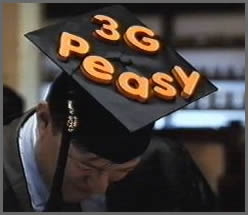 Currently Vodafone have a bigger network than Orange, so Orange would gain more than Vodafone from the deal, but in future it means that new cell sites will be used by both operators.
Currently Vodafone have a bigger network than Orange, so Orange would gain more than Vodafone from the deal, but in future it means that new cell sites will be used by both operators.
The agreement could have covered 2G (GSM) too, but as Vodafone use 900MHz systems and Orange use different systems operating in the 1800MHz band, it just not possible. That said, it’s likely future technology would allow both sets of frequencies to operate within the same radio equipment.
There will still be interesting problems to sort out for 3G sharing, as Vodafone exclusively use equipment from Ericsson, while Orange use equipment from Nortel, Siemens, Nokia and Alcatel.
Once the network is in place, each network will be responsible for enabling their own network services and ensuring quality of service, etc. As competition for customers increases this is a sensible way for operators to reduce cost, share the infrastructure and compete on service. It’s a shame the fixed networks don’t take this view, as has been pointed out before, the LLU operators could join forces and build a joint LLU network and then compete on service. This might give them a larger network, which would be of a size and scale to compete with BT’s upcoming 21CN.
 Why the rush to build?
Why the rush to build?
With a 3G license comes obligations and one of these was to reach 80% of the population by the 1st Dec, 2007. Though the GSM network coverage hit that a while ago, 3G expansion has been slower with few customers really wanting 3G services so the operators have built 3G networks in densely populated areas where they can make revenue from those customers. That means big cities have been covered, but elsewhere 3G coverage is patchy to say the least.
Hutchinson 3G (or 3 the new entrant into the mobile world) has been rapidly building its customer base and building a network to match. In June 2004, Ofcom tried rules that 3 had SMP (significant market power) in the 3G world, which meant it would be regulated by Ofcom much in the same way BT is for fixed networks. The other 3G operators happily supported Ofcom in this view. 3 didn’t want the increased regulatory burden and disagreed with Ofcom’s ruling, so appealed to the Competition Appeal Tribunal. They won their appeal in November 2005. This was the first time any network has successfully appealed against a SMP designation.
3 wasn’t happy about having SMP forced upon it and therefore made noises to Ofcom about coverage obligations, which the other networks weren’t meeting. They’ve got 10 months to hit that 80% figure.
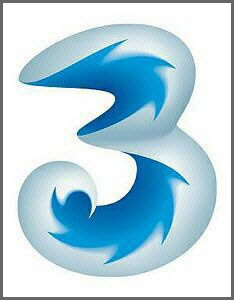 Though city centres might have a demand for 3G (for data services, no one cares about 3G voice – a voice call sounds the same whether it’s 3G or GSM), as you leave dense urban areas the appeal of 3G is less. Well maybe not less, but there are less people to use it and less of a reason for the networks to install 3G infrastructure and sites.
Though city centres might have a demand for 3G (for data services, no one cares about 3G voice – a voice call sounds the same whether it’s 3G or GSM), as you leave dense urban areas the appeal of 3G is less. Well maybe not less, but there are less people to use it and less of a reason for the networks to install 3G infrastructure and sites.
The cost of a 3G cell is probably not much different in terms of equipment from that of a 2G cell, one major difference is the amount of bandwidth needed for the cell, as data volumes are significantly higher (maybe 40Kb/s using GPRS data compared to maybe 2Mb/s for 3G, multiply that by 10 users and it’s 400Kb/s compared to 200Mb/s).
UK backhaul (i.e. the pipes used to connect cells) are expensive. The more rural the cell site is. the less chance there is that anyone (except maybe BT) has got any kind of high bandwidth connectivity. Therefore, the costs of the backhaul may well exceed that of the cell site itself.
Sharing makes economic sense
Orange and Vodafone have to hit that 80% figure or Ofcom can impose fines which could be significant. Therefore the build out of a shared new network makes economic sense. It’s half of what they’d each have to pay.
In this climate of everyone’s customers wanting everything for nothing, being able to reduce your build costs may well be the straw that doesn’t break the camel’s back.
 Car rental giants Avis have starting offering their Autonet Mobile-based Wi-Fi service – known as Avis Connect – in their rental vehicles.
Car rental giants Avis have starting offering their Autonet Mobile-based Wi-Fi service – known as Avis Connect – in their rental vehicles.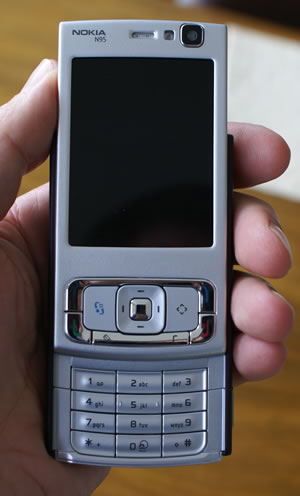 Okay, time to try out the device’s killer app – GPS and Nokia Maps. Having previously owned a Garmin Trek and an ill-fated Ipaq 6915, I’m familiar with the sluggishness of finding an initial navigating signal, so I’m giving the Nokia plenty of leeway to be a bit slow at first.
Okay, time to try out the device’s killer app – GPS and Nokia Maps. Having previously owned a Garmin Trek and an ill-fated Ipaq 6915, I’m familiar with the sluggishness of finding an initial navigating signal, so I’m giving the Nokia plenty of leeway to be a bit slow at first. Three UK operators will be taking part, Orange, Vodafone and 3 giving subscribers to the trial the ability to watch BBC One, BBC News 24 and BBC Three streamed on their mobiles. Beyond some sports programmes and programmes where they don’t have the necessary rights.
Three UK operators will be taking part, Orange, Vodafone and 3 giving subscribers to the trial the ability to watch BBC One, BBC News 24 and BBC Three streamed on their mobiles. Beyond some sports programmes and programmes where they don’t have the necessary rights.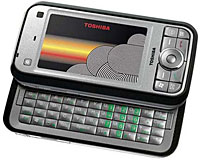 A cavalcade of new phones are continuing to spew forth from the 3GSM World Congress bash in Barcelona, and one that has especially warmed our toilet seats of desire is the ‘G900’ smartphone from Toshiba.
A cavalcade of new phones are continuing to spew forth from the 3GSM World Congress bash in Barcelona, and one that has especially warmed our toilet seats of desire is the ‘G900’ smartphone from Toshiba.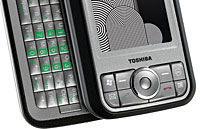 To ensure that the vast display is topped up with fast and fresh web pages there’s ultra-nippy HSDPA connectivity onboard (take that, iPhone!), with 64MB of internal memory and a miniSD card taking care of storage duties.
To ensure that the vast display is topped up with fast and fresh web pages there’s ultra-nippy HSDPA connectivity onboard (take that, iPhone!), with 64MB of internal memory and a miniSD card taking care of storage duties. Extra security comes in the form of a rear biometric scanner, and there’s also Bluetooth with A2DP support, Wi-Fi, USB On-The-Go and Microsoft’s new Windows Mobile 6 OS.
Extra security comes in the form of a rear biometric scanner, and there’s also Bluetooth with A2DP support, Wi-Fi, USB On-The-Go and Microsoft’s new Windows Mobile 6 OS.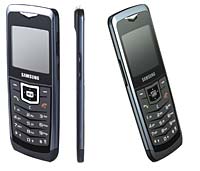 There may be controversy on the catwalks, but thin remains in with the design bods at Samsung, who have just unleashed a trio of anorexic handsets in their Ultra range, the U300, U600, U700 and ultra-thin U100.
There may be controversy on the catwalks, but thin remains in with the design bods at Samsung, who have just unleashed a trio of anorexic handsets in their Ultra range, the U300, U600, U700 and ultra-thin U100.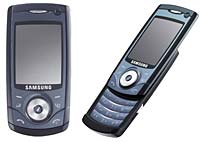 Back to the real world, there’s no denying that the U100 is an impressive piece of engineering – and purdy as a picture too – packing in a 3 mega-pixel camera, a 1.93″ color TFT screen and 11 hours of music play time into its 5.9mm wide frame.
Back to the real world, there’s no denying that the U100 is an impressive piece of engineering – and purdy as a picture too – packing in a 3 mega-pixel camera, a 1.93″ color TFT screen and 11 hours of music play time into its 5.9mm wide frame. Adjusting the BS output to ‘stun,’ the press announcement tells us that the handset apparently exudes “elegance and modern style… for the ultimate sophistication” and comes in a suitably daftly-named set of colours, including sapphire blue, garnet red, platinum metal and copper gold casing.
Adjusting the BS output to ‘stun,’ the press announcement tells us that the handset apparently exudes “elegance and modern style… for the ultimate sophistication” and comes in a suitably daftly-named set of colours, including sapphire blue, garnet red, platinum metal and copper gold casing. 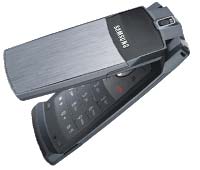 Wrapping up the new line-up is the U300, a 9.6-mm clamshell with a 3-megapixel camera, Bluetooth, TV-out capability and 70MB of onboard storage (but no MicroSD slot).
Wrapping up the new line-up is the U300, a 9.6-mm clamshell with a 3-megapixel camera, Bluetooth, TV-out capability and 70MB of onboard storage (but no MicroSD slot).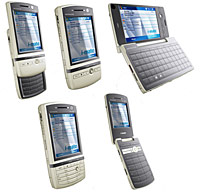 In an advanced Hedge-Betting exercise, i-mate has announced its new range of Windows Mobile devices, with a set of designs mirroring just about every handset currently available on the market.
In an advanced Hedge-Betting exercise, i-mate has announced its new range of Windows Mobile devices, with a set of designs mirroring just about every handset currently available on the market.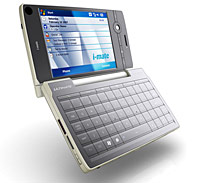 Christened the “Ultimate” range, the WM6-powered devices – all five of ’em – are numbered 5150, 6150, 7150, 9150, and 8150 (clockwise from the upper left in the compilation photo) – if you’re bored, you can play “spot the inspiration” and see if you match i-mate’s new offerings to current designs by other manufacturers.
Christened the “Ultimate” range, the WM6-powered devices – all five of ’em – are numbered 5150, 6150, 7150, 9150, and 8150 (clockwise from the upper left in the compilation photo) – if you’re bored, you can play “spot the inspiration” and see if you match i-mate’s new offerings to current designs by other manufacturers. Full details of the whole range are still dribbling through, but we’ve learnt that the Ultimate 5150 slider comes with an Intel Bulverde 520MHz CPU, VGA screen, 256MB ROM and 128MB RAM, Wi-Fi, microSD memory card slot and a 2.0 megapixel camera.
Full details of the whole range are still dribbling through, but we’ve learnt that the Ultimate 5150 slider comes with an Intel Bulverde 520MHz CPU, VGA screen, 256MB ROM and 128MB RAM, Wi-Fi, microSD memory card slot and a 2.0 megapixel camera.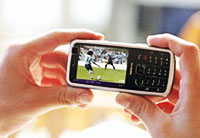 Nordic big-knobs Nokia have knocked out another two handsets for your delectation today.
Nordic big-knobs Nokia have knocked out another two handsets for your delectation today.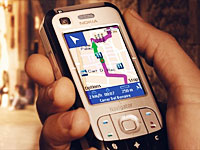 Lurking on the back is a 2 megapixel camera, with the N77 delivering on the multimedia front, offering visual radio and support for MP3, AAC, AAC+, eAAC+ and WMA media.
Lurking on the back is a 2 megapixel camera, with the N77 delivering on the multimedia front, offering visual radio and support for MP3, AAC, AAC+, eAAC+ and WMA media. Nokia E90 Communicator
Nokia E90 Communicator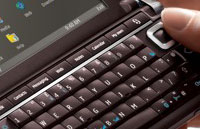 There’s also integrated GPS and Nokia Maps wedged into the chunky handset, but all those features are going to come at a wallet-whipping price, with the E90 expected to be priced at around a stratospheric €750.
There’s also integrated GPS and Nokia Maps wedged into the chunky handset, but all those features are going to come at a wallet-whipping price, with the E90 expected to be priced at around a stratospheric €750.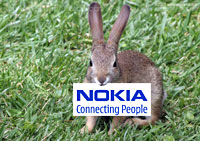 Nokia, the undisputed heavyweight champs of the mobile phone world, have taken the wraps off their new 6110 Navigator smartphone.
Nokia, the undisputed heavyweight champs of the mobile phone world, have taken the wraps off their new 6110 Navigator smartphone. According to Nokia, they will be offering the smart2go on Nokia S60 and Windows Mobile 5.0 devices, and then rolling out support for most of the major mobile OS platforms including Nokia S60/S40, PocketPC, Linux and other Windows Mobile devices.
According to Nokia, they will be offering the smart2go on Nokia S60 and Windows Mobile 5.0 devices, and then rolling out support for most of the major mobile OS platforms including Nokia S60/S40, PocketPC, Linux and other Windows Mobile devices. UPDATE: Image through now …. der dah!
UPDATE: Image through now …. der dah! We thought it would be worthwhile taking a look as to why this might be happening and why it’s come at this time.
We thought it would be worthwhile taking a look as to why this might be happening and why it’s come at this time. Currently Vodafone have a bigger network than Orange, so Orange would gain more than Vodafone from the deal, but in future it means that new cell sites will be used by both operators.
Currently Vodafone have a bigger network than Orange, so Orange would gain more than Vodafone from the deal, but in future it means that new cell sites will be used by both operators. Why the rush to build?
Why the rush to build? Though city centres might have a demand for 3G (for data services, no one cares about 3G voice – a voice call sounds the same whether it’s 3G or GSM), as you leave dense urban areas the appeal of 3G is less. Well maybe not less, but there are less people to use it and less of a reason for the networks to install 3G infrastructure and sites.
Though city centres might have a demand for 3G (for data services, no one cares about 3G voice – a voice call sounds the same whether it’s 3G or GSM), as you leave dense urban areas the appeal of 3G is less. Well maybe not less, but there are less people to use it and less of a reason for the networks to install 3G infrastructure and sites.